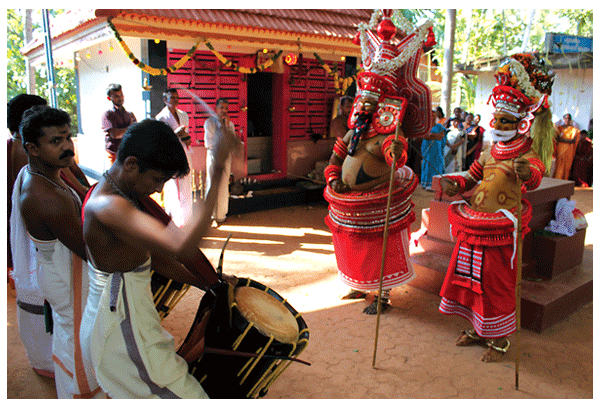- Prelude
- Editorial
- A time to Act
- Raja Ravi Varma: The painter who made the gods human
- Rabindranath as Painter
- Gaganendranath: Painter and Personality
- Abanindranath Tagore: a reappraisal
- Where Existentialism meets Exiledom
- Nandalal Bose
- Jamini Roy's Art in Retrospect
- Sailoz: The Inerasable Stamp
- Amrita Sher-Gil
- Calcutta's Best Kept Secret: The Marble Palace
- Art is Enigmatic
- A few tools to protect the French culture
- The exact discipline germinates the seemingly easiness
- Symbols of Monarchy, power and wealth the Turban Ornaments of the Nizams
- The Bell Telephone
- The Pride of India
- Tapas Konar Visualizing the mystic
- Theyyam
- Our Artists vs. their Artists
- Dragon boom or bubble?
- What Happened and What's Forthcoming
- Art Bengaluru
- Musings from Chennai
- Art Events Kolkata: May – June 2011
- Mumbai Art Sighting
- Previews
- In the News
ART news & views
Theyyam
Volume: 3 Issue No: 18 Month: 7 Year: 2011
Photo Essay
by Vikram Zutshi
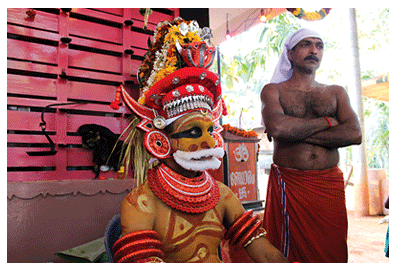 Theyyam is a popular ritual form of worship in North Malabar, Kerala, predominant in the districts of Kasargod, Kannur, Wayanad and Kozhikode. The term Theyyam is a corrupt form of 'Daivam' or God. It is representative of a form of Hinduism (albeit non-Brahminical) having been practiced by tribal communities since time immemorial. This form of worship, often involving liquor and meat as offerings to Bhagawathi, Shiva, Vishnu, co-existed with the Sattvic rituals practised by Nambudiri Brahmins in temples. People of these districts believe Theyyam to be a living deity from whom they seek blessings.
Theyyam is a popular ritual form of worship in North Malabar, Kerala, predominant in the districts of Kasargod, Kannur, Wayanad and Kozhikode. The term Theyyam is a corrupt form of 'Daivam' or God. It is representative of a form of Hinduism (albeit non-Brahminical) having been practiced by tribal communities since time immemorial. This form of worship, often involving liquor and meat as offerings to Bhagawathi, Shiva, Vishnu, co-existed with the Sattvic rituals practised by Nambudiri Brahmins in temples. People of these districts believe Theyyam to be a living deity from whom they seek blessings.
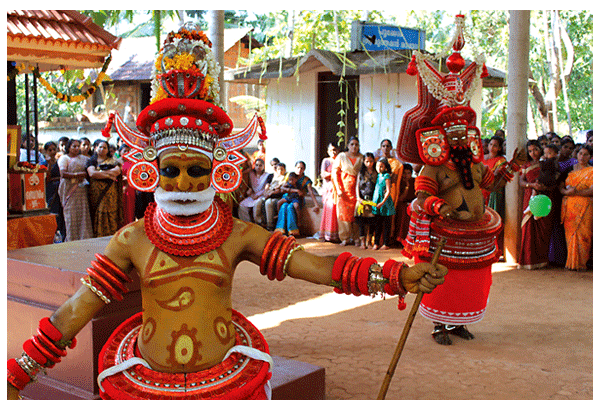
Muthappan
Being one of the principal deities in Theyyam, the ritual performers of Muthappan belong to the indigenous, tribal community of Kerala. Unique to Kerala, both the upper-caste Brahmins,  and the lower-caste tribals are accorded equal status over the course of the ritual.
and the lower-caste tribals are accorded equal status over the course of the ritual.
The performance has two main 'actors': Muthappan and Thiruvappan. They are considered to be manifestations of Shiva and Vishnu respectively. Therefore Muthappan as a whole represents the idea of Brahman, the unity of manifested creation with the totality of the cosmos, as expressed in the Vedas.
Muthappan worship does not follow the Sattvic (Brahminical) form of worship, as in other Hindu temples. The main mode of worship is not via idol worship, but via a ritual enactment of this age old performance art form.
Fish is used as an offering and people of all castes, religions and nationalities are permitted to enter the temple and take part in the worship.
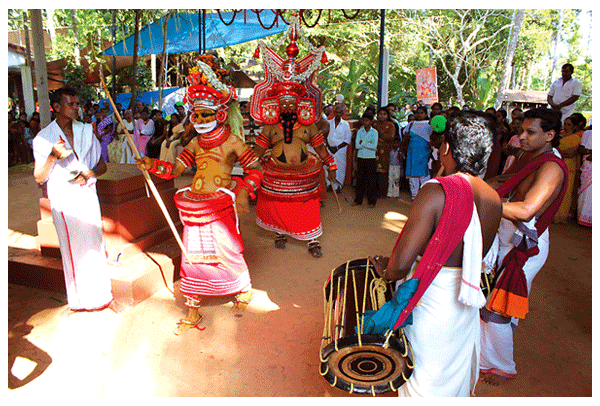
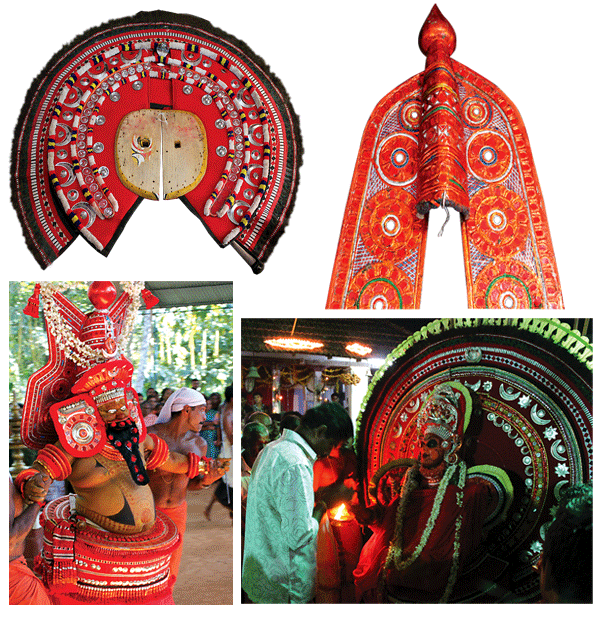
Theyyam Costumes:
 Theyyam costumes are fashioned from cutting and painting coconut sheaths in primarily black, white and red patterns. The richly textured and intricate facial designs are age old, symbolic visual codes handed down over several generations through the same family lineage. Theyyam is performed in the 'Kaavu', i.e the courtyard of a house or village temple, as the artist prepares for his nocturnal ritual trance during which the spirit of the deity is evoked. The hood, headdress, face paint, breastplate, bracelets, garlands and fabric of attire of each theyyam are distinct and painstakingly crafted over long hours prior to the performance.
Theyyam costumes are fashioned from cutting and painting coconut sheaths in primarily black, white and red patterns. The richly textured and intricate facial designs are age old, symbolic visual codes handed down over several generations through the same family lineage. Theyyam is performed in the 'Kaavu', i.e the courtyard of a house or village temple, as the artist prepares for his nocturnal ritual trance during which the spirit of the deity is evoked. The hood, headdress, face paint, breastplate, bracelets, garlands and fabric of attire of each theyyam are distinct and painstakingly crafted over long hours prior to the performance.
 Theyyam is an ancient form of what is today known as 'performance art' in which transcendental expressions of higher dimensional entities are conveyed to a believer through a flesh and blood template, i.e the mortal coil. It posits the notion of several parallel universes and perpetuates the theory that a human being after appropriate metaphysical initiation, can mount the physical or external effects of a specific entity/being/deity and then 'become' that entity. In this exalted state he takes on superhuman and divine power speaking, moving, blessing and healing as a god or goddess.
Theyyam is an ancient form of what is today known as 'performance art' in which transcendental expressions of higher dimensional entities are conveyed to a believer through a flesh and blood template, i.e the mortal coil. It posits the notion of several parallel universes and perpetuates the theory that a human being after appropriate metaphysical initiation, can mount the physical or external effects of a specific entity/being/deity and then 'become' that entity. In this exalted state he takes on superhuman and divine power speaking, moving, blessing and healing as a god or goddess.
